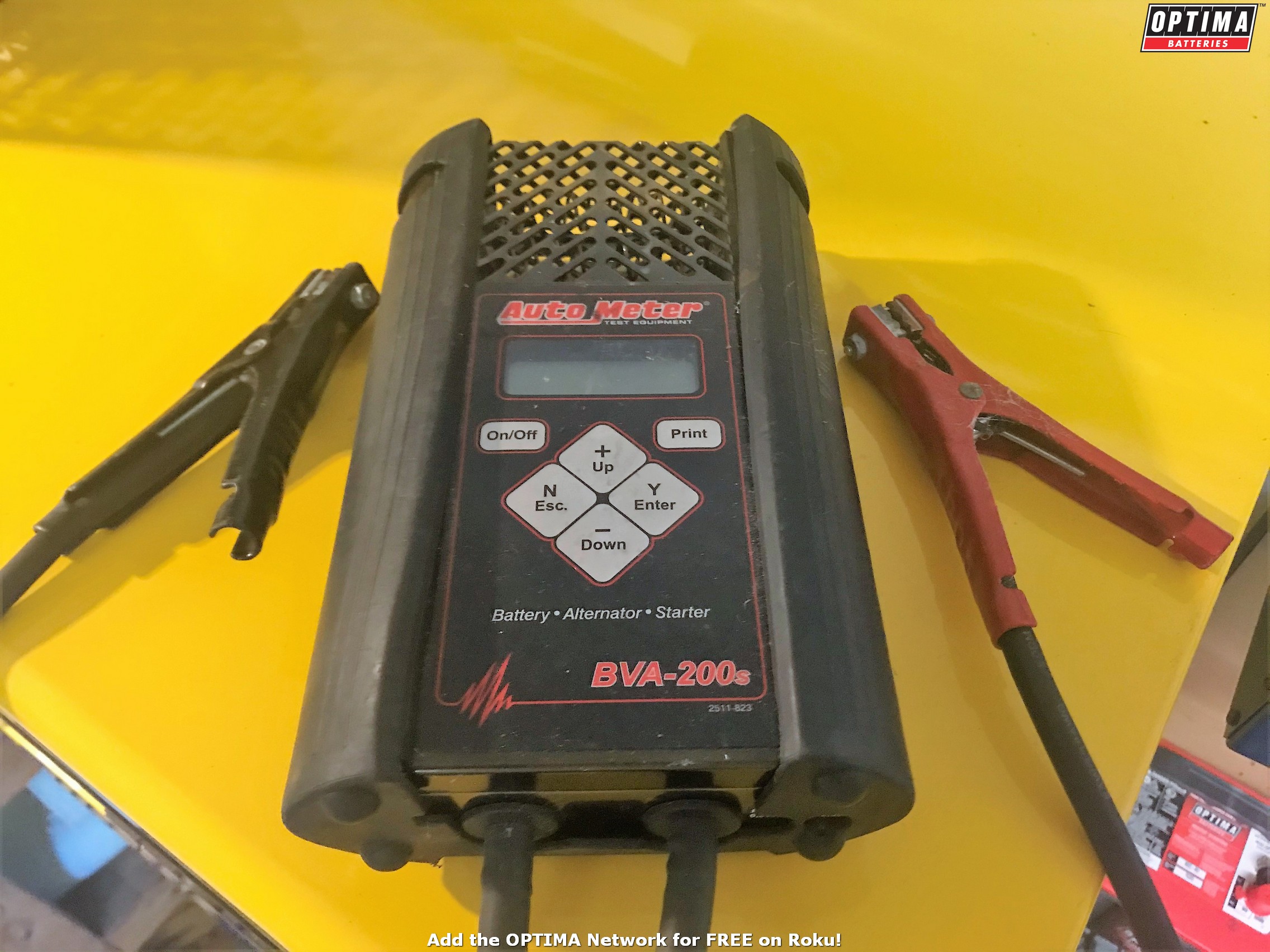What Are Signs of a Bad Battery?

- Sponsor
- Location


Fake News! We've heard that phrase
thrown around quite a bit the past few years and the truth of the
matter is, fake news about car batteries is a real thing as well. If
someone runs a search on the Internet to figure out when it's
time to replace their car battery, they'll probably get back a bunch
of links to lists of “signs it's time to replace your car battery.”
Most bear a striking resemblance to the others, because they
were probably copied and pasted from the same source. Many of these
lists were then edited to be “unique” by someone who doesn't know
the first thing about cars or car batteries, before being posted onto
a website that might have little or nothing to do with car batteries.
One day they post about replacing a car battery, the next day they
post about changing the water filter on your refrigerator. They don't
even care if what they post is actually correct. All they really care
about is getting visitors to their website. How do you know that? Because the
best way to know if your battery needs to be replaced doesn't make
any of their lists!
We are a car battery company and we do
want your business, but not before you need to give it us. That's why
we want to go through the long list of supposed signs that suggest
it's time to replace your car battery and explain why they might not
be true. Before we do that, we want to give you the best way to
determine if your car battery needs to be replaced- have your car
battery load-tested by a professional.
That may sound
expensive, but it isn't. Most auto parts stores offer load tests on
car batteries and many will do it for free. Just make sure your
battery is fully-charged (at least 12.6 volts) when they test it, to
make sure the results are as accurate as possible. Battery load
testers come in all different shapes & sizes, but many units are
hand-held, like the one in the photo above, so you don't even need to
remove your battery from your car to have it tested.
Now that
we've got that out of the way, let's get to the fake news and debunk
the symptoms others suggest are definitive signs your battery needs to be
replaced. While some of them could indicate your battery is in
trouble, there's often more going on than just a singular symptom and
a singular cause.
Your headlights are dim. Once you start your
car, electrical demands should be covered by the vehicle charging
system. If your headlights start dimming when your vehicle is
running, it probably doesn't have anything to do with the health of
your battery. You might have a loose or worn belt that is slipping
and may not be spinning your alternator fast enough. A bad tensioner
pulley can also cause this to happen, as well as an alternator that
is on it's way out. If your headlights are dimming that means the
energy that is supposed to be going into the battery from your charging system probably isn't getting there either, so if
you don't address this issue, it will eventually result in your
battery needing to be replaced. However, that doesn't mean your
battery is the source of the issue or that replacing it will resolve your issues.
Clicking sound when you turn the key. Did you
know many of the batteries returned to us under warranty are just
discharged and work fine, when properly-recharged? If you try to
start your car with a discharged battery, it might make a clicking
sound. While that could mean it is time to replace your battery,
which could cost $150 or more, but it could also mean it is time to
charge your battery, which may cost you a few hours of time and just a few
cents of electricity. We mentioned 12.6 volts earlier and we'll
repeat it again, because it is important. If your battery voltage is
well below 12.6 volts, it might just be discharged, so try charging your battery before replacing it.
Slow crank. Car batteries typically
don't go straight from firing up your engine in less than a second to
the engine making a clicking sound. An engine that is slow to crank
and start up could be one of the first signs that your battery isn't
fully-charged. While it is true that batteries that need to be
replaced will take longer to start your car, that is often not the
case. If you parked your car at the airport for a few weeks or
haven't driven much during a pandemic, there's a good chance your car
has been discharging your battery as it sat unused. That might make
it start slowly, but it doesn't necessarily mean your battery needs
to be replaced. Try charging it first.
Needing to press the
gas pedal to start the car. While fuel-injected cars probably have no
need to press the gas pedal to start, pressing the gas pedal may be
common practice in many carbureted cars and trucks, especially if
they haven't been driven in a while. If you find yourself pressing
the gas pedal to start your fuel-injected vehicle, first check the
battery voltage, then have your battery load-tested before you commit
to replacing it. You might find that like the slow-cranking engine,
your battery just needs to be charged.
Backfiring. When you
start looking at these symptoms others suggest are caused by a bad
battery, it makes you think the battery is more important than the
engine. Not every problem that pops up with your car gets traced back
to the battery, although, because it is one of the easiest things to
replace, it's often where people start. If your car is backfiring,
there are a lot of things to look at, but the battery is low on the
list of suspects and easy enough to dismiss with a voltage check and
load test. Remember, once a car is started, electrical demands should
be handled by the vehicle's charging system. Backfiring is far more
likely to be a fuel system-related issue.
Old age. This is
low-hanging fruit when it comes to calling out reasons to replace
your battery. What typically follows is a line about most car
batteries lasting about three to five years. Did you know OPTIMA
batteries can last up to three times as long as a flooded lead-acid
battery? With that being the case, what is considered “old” for a
battery? Most sites won't begin to broach that subject, but we'll
tell you areas with extreme temperatures, both hot and cold, will go
through batteries faster than areas with more moderate temperatures. A three-year old battery could be old for a car in Phoenix, but it could
have another five to ten years left if it is in San Diego. If you think your
battery is getting old, have it load-tested.
Battery leaking.
A leaking battery is never a good thing, but it could mean there are
issues with your charging system that could be causing the leaking.
OPTIMA batteries are completely sealed, so the only time we typically
see them leaking is if they are severely overcharged. Other flooded
batteries may vent and leak more as they age, but we'll sound like a
broken record here- if your voltage is good and your battery passes a
load test, start taking a harder look at your charging
system.
Swelling/bloating battery case. Sulfation builds up in
batteries as they age and this can cause the battery case to look
swollen or bloated, but this can also be caused by overcharging a
battery. Bad voltage regulators can allow car batteries to be
overcharged, but we often see this happen with older battery chargers
or the big shop chargers used at dealerships and service stations.
When you push a lot of current into a car battery very quickly, it
can get hot and the case can expand as that internal pressure looks
for ways to escape.
Low battery fluid level. OPTIMA
batteries are sealed, absorbed glass-mat batteries, so the fluid that
goes into them stays there. For flooded lead-acid batteries, that
fluid may vent as a battery goes through the charge/discharge cycle.
However, many of those batteries are being marketed as
“maintenance-free.” That references the fact that you don't need
to or cannot add distilled water or electrolyte (we'd probably never
call it “battery fluid”). Besides that, unless you have a
hydrometer in your tool box and an unsealed battery, how will you
even know if the levels are low?
Check engine light. Most cars
that have a check engine light also have a check battery light that
will illuminate if there is an issue with your battery or charging
system. There are literally too many issues that could trigger a
check engine light to list here, so don't jump to the conclusion that
it means it's time to replace your battery. If your voltage is good
and your battery passes a load test, look elsewhere for the source of
this light.
A bad smell. That's a very broad symptom and while
it could be traced back to a battery that is venting flammable and
toxic fumes, a bad smell might not be the battery's fault. A bad smell could
also be a catalytic converter going bad or a dead animal getting
cooked in the engine compartment or fruit rotting underneath your
seat. If you want to see if the battery is responsible, you know what
to do by now- check voltage and have it load-tested.
Corroded connectors. This is another
one of those issues that you shouldn't have with an OPTIMA battery, as
their sealed design eliminates corrosion at the battery terminals.
However, that doesn't mean corrosion wasn't there before an OPTIMA
battery was installed. The corrosion should be cleaned off because it
inhibits good electrical flow, but if that corrosion happened when
the previous battery was in the car, it may have nothing to do with
your new battery or be an indication that it needs to be replaced.
If you haven't figured it out yet, we're really big fans of having your battery load-tested by a professional. It's about as easy and definitive a way as there is to determine if your battery needs to be replaced or if one of these symptoms is being caused by something other than your battery. If you want to maximize the performance and lifespan of your 12-volt car or truck battery, keep it fully-charged whenever possible with an OPTIMA Charger or Maintainer.
